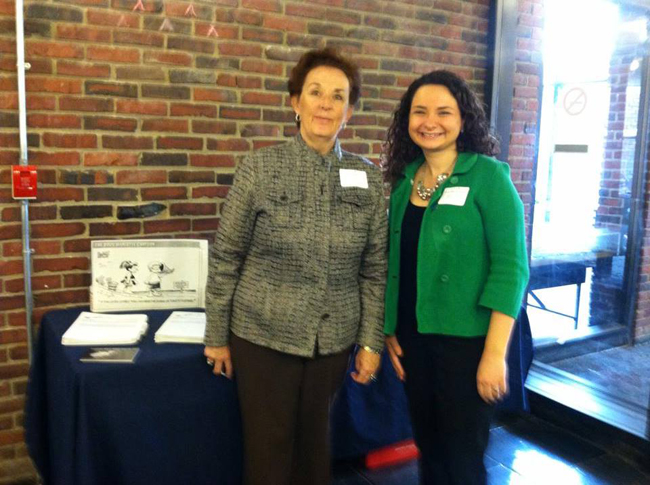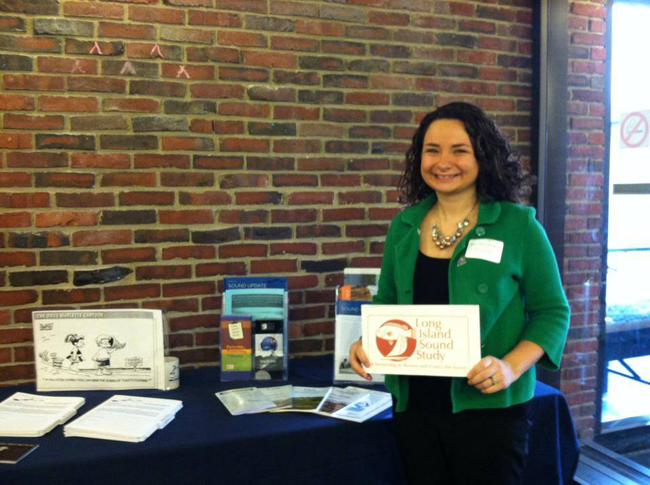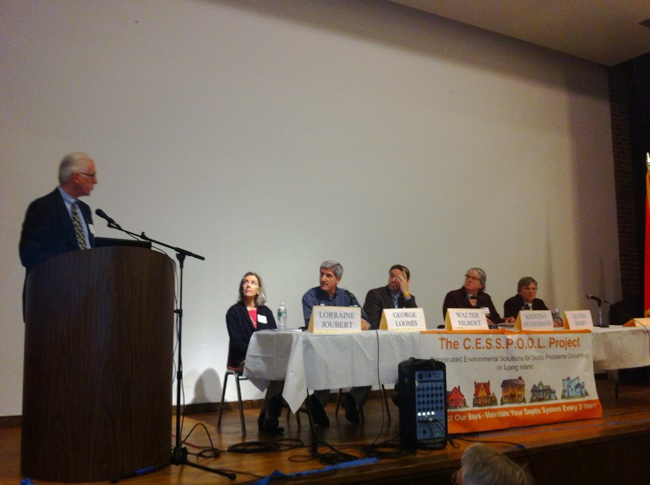Stony Brook, NY, April 17, 2014 - On March 25, 2014, at the scenic Old Bethpage Restoration Village on Long Island, approximately 130 coastal managers, septic and cesspool company business owners, researchers, water quality professionals, elected officials, engineers and concerned citizens gathered to hear experts deliver much needed information about the state of Long Island’s cesspools and septic systems and where we go from here. Kicking off the morning slate of speakers was
Eileen Keenan, Manager of New York Sea Grant’s Nonpoint Education for Municipal Officials Program. Keenan’s clear overview of the issue got right to the point: whereas much of Nassau County’s population utilizes sewers, most of Suffolk County’s population uses on-site wastewater treatment systems (OWTS), many of them situated on poor soils, inadequately built, and in need of upgrading or replacement. Pathogens and nitrogen from OWTS travel from septic systems through groundwater and ultimately impair the surface water. Keenan called for better integration of waste water management and efforts to address coastal hazards and sea level rise.

Standing in front of the Long Island Sound Study table are Eileen Keenan, Manager of the Nonpoint Education for Municipal Officials (NEMO) Program with New York Sea Grant and
Amy Mandelbaum, Long Island Sound Study Outreach Coordinator with New York Sea Grant. Photo: Courtesy of Long Island Sound Study

Standing in front of the Long Island Sound Study table is Amy Mandelbaum, Long Island Sound Study Outreach Coordinator with New York Sea Grant. Photo: Courtesy of Long Island Sound Study
More technical specifics about OWTS – what they do and how they generate pollutants – came from
George Loomis, Director of the University of Rhode Island New England Onsite Wastewater Training Center. With numerous slides and schematics, he introduced the audience to some of the techniques and products now available and being used in nearby Rhode Island where development abuts the water bodies and the soil types are similar to those on Long Island. Loomis and colleague
Lorraine Joubert, the Director of URI’s Nonpoint Education for Municipal Officials program continued the discussion into the afternoon session as they discussed 30+ years of mitigating the impacts of OWTS.
Suffolk County’s public health engineer, Walter Hilbert, outlined what is transpiring at the county level as Suffolk looks at major systems in communities in the Peconic Estuary, Long Island Sound and Great South Bay on a case-by-case basis. The county will look at groundwater modeling and wastewater planning to produce maps and evaluate the costs in very real terms: in dollars per pound of nitrogen. The county is working with Stony Brook University to develop the NY State Water and Environmental testing lab to research and commercialize the next generation of wastewater treatment technology.
Architect
Gynnis Berry, the director of Peconic Green Growth, educated the audience by showing GIS maps of the east end of Long Island, emphasizing how the maps show just how little time it takes for wastewater from individual septic systems to enter the waterways.
Kristina Heinemann from the US Environmental Protection Agency, Region 2, discussed how the EPA has prepared guidelines for several models of on-site systems. These range from individual homeowners who monitor their own system maintenance (and sometimes “flush and forget”) to larger scale systems that are maintained with service contracts, to those companies and businesses known as RMEs (responsible management entities) who have trained personnel and operating permits to keep systems working at peak performance. The EPA has numerous fact sheets about septic systems and maintenance in its series “Clean Water Starts at Home.”
Nassau County Department of Public Works was also represented at the conference with a discussion of the all-important inter-municipal partnerships that must be developed to address OWTS impacts.
 Jamie VanDyke
Jamie VanDyke, from Nassau County Soil and Water Conservation District, and Eileen Keenan, NYSG's NEMO Program Manager, address the crowd at the conference. Photos: Courtesy of Manhasset Bay Protection Committee
An afternoon Q & A with the speakers and closing remarks of the conference point to the fact that municipal officials, water-protection entities, and septic-related business owners agree that working together and getting information and training is key to effective mitigation of OWTS impacts.

Q&A at the Managing Cesspools and Septic Systems to Protect LI's Waters conference. Photo: Barbara Branca, NYSG
The conference was sponsored by the Hempstead Harbor Protection Committee, Friends of the Bay, the Manhasset Bay Protection Committee, the Oyster Bay/ Cold Spring Harbor Protection Committee, The Town of Oyster Bay, and New York Sea Grant. It was made possible by a grant from the Long Island Sound Futures Fund and the Long Island Sound Study.
—Barbara A. Branca, NYSG Communications Manager; Eileen Keenan, NYSG's NEMO Program Mananger
More Info: New York Sea Grant
New York Sea Grant (NYSG), a cooperative program of Cornell University
and the State University of New York, is one of 33 university-based
programs under the National Sea Grant College Program (NSGCP) of the
National Oceanic and Atmospheric Administration (NOAA). The NSGCP
engages this network of the nation’s top universities in conducting
scientific research, education, training and extension projects designed
to foster science-based decisions about the use and conservation of our
aquatic resources. Through its statewide network of integrated
services, NYSG has been promoting coastal vitality, environmental
sustainability, and citizen awareness about the State’s marine and Great
Lakes resources since 1971.
For updates on Sea Grant activities:
www.nyseagrant.org has RSS,
Facebook,
Twitter, and
YouTube links. NYSG also offers a free e-list sign up via
www.nyseagrant.org/coastlines for
NY Coastlines, its flagship publication, which, in 2014, merges with the program's e-newsletter,
Currents.
NY Coastlines is published several times a year.